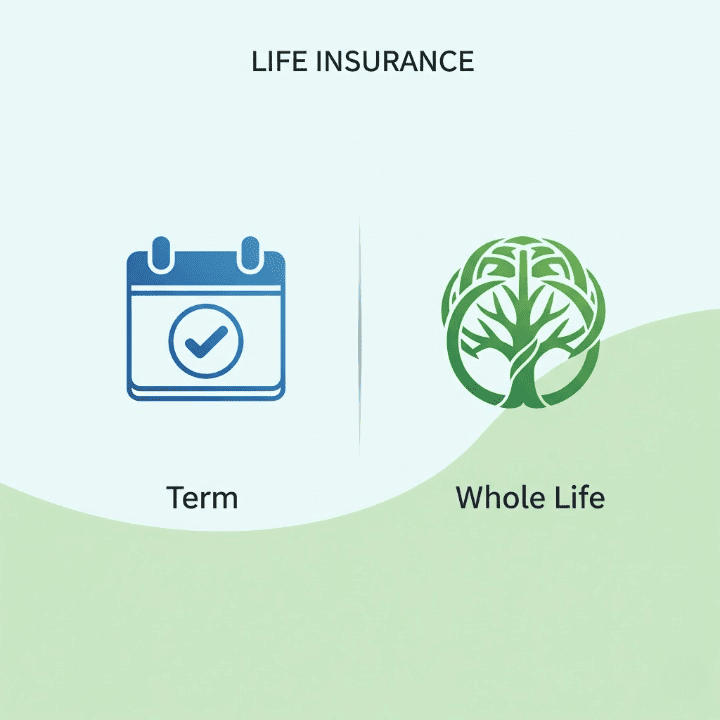
Introduction
Many people find themselves confused by life insurance. They know it’s important, but they often struggle to understand the different types of policies, how they work, and which one is right for their specific needs. The decision between term and whole life insurance is one of the biggest and most significant choices you will make. This choice can have a profound impact on your family’s financial security for decades. Life insurance isn’t just a product; it’s a foundational element of sound financial planning. It provides a safety net, ensuring your loved ones are protected from financial hardship in the event of your death. This comprehensive guide will demystify term and whole life insurance, exploring their key differences, benefits, and drawbacks. Our goal is to empower you with the knowledge to make an informed decision and find a policy that truly protects your family’s future.
Understanding the Core Purpose of Life Insurance
Before diving into the policy types, let’s first clarify the fundamental role of life insurance. At its core, life insurance is a contract between you and an insurance company. In exchange for regular premium payments, the insurer agrees to pay a lump sum, known as the death benefit, to your designated beneficiaries upon your death. This death benefit is typically a tax-free payout. It can be used for various purposes, such as covering funeral expenses, paying off outstanding debts (like a mortgage or car loans), replacing your income to support your family’s living expenses, funding your children’s education, or even serving as a legacy to a charity. The primary purpose is to provide financial security and stability to those who depend on you.
Term Life Insurance: Pure Protection for a Specific Period
Term life insurance is the simplest and most straightforward form of coverage. As the name suggests, it provides coverage for a specific period, or “term,” typically ranging from 10 to 30 years.
How It Works
When you purchase a term life policy, you choose a coverage amount and a term length. For example, you might get a $500,000 policy for a 20-year term. You pay a fixed premium each month for the entire term. If you pass away within that 20-year period, your beneficiaries receive the $500,000 death benefit. If you outlive the term, the policy simply expires, and there is no payout. Think of it like renting insurance: you pay for the coverage you need for the time you need it.
Key Benefits
- Affordability: Term life insurance is significantly cheaper than whole life. This makes it a great option for people who need substantial coverage but have a limited budget, especially young families with a mortgage and young children.
- Simplicity: The policy is easy to understand. You get a set death benefit for a set period. There are no complex investment components to worry about.
- Flexibility: You can choose a term that aligns with your specific financial responsibilities, such as the duration of your mortgage or until your children are financially independent.
Key Drawbacks
- No Cash Value: Term policies have no savings or investment component. Once the term ends, the policy has no value.
- Temporary Coverage: The policy expires. If you still need coverage after the term ends, you may need to purchase a new policy at a much higher premium, as your age and health have changed.
Whole Life Insurance: Lifetime Protection with a Savings Component
Whole life insurance is a type of permanent life insurance. It provides coverage for your entire life, as long as you pay the premiums.
How It Works
Whole life policies are more complex than term policies. They have two main components: a death benefit and a cash value. A portion of your premium goes toward the death benefit, while the other portion goes into a tax-deferred savings or investment account, known as the cash value. This cash value grows over time at a guaranteed rate. You can borrow against it or withdraw from it during your lifetime.
Key Benefits
- Lifetime Coverage: As long as you pay the premiums, the policy will never expire. This guarantees that your beneficiaries will receive a death benefit regardless of when you pass away.
- Cash Value Growth: The cash value component grows over time. It can provide a source of funds for emergencies or other financial needs.
- Stable Premiums: Premiums for whole life policies are typically fixed and will never increase, which makes long-term budgeting easier.
- Tax Advantages: The cash value grows tax-deferred, and the death benefit is usually tax-free.
Key Drawbacks
- High Cost: Whole life insurance is significantly more expensive than term life insurance, often by a factor of 5 to 15 times.
- Lower Rate of Return: The growth rate of the cash value is usually modest, often lower than what you could achieve by investing the difference in premiums in a separate account, such as an investment portfolio.
- Complexity: The policies can be confusing and may involve complex riders and clauses.
The Big Question: Which Policy is Right for You?
Choosing between term and whole life insurance depends entirely on your personal circumstances, financial goals, and priorities. There is no one-size-fits-all answer.
Choose Term Life If:
- You have a limited budget but need a large amount of coverage.
- Your main financial responsibilities are temporary, like a mortgage or raising children.
- You prefer to keep your insurance and investing separate. You can buy a term policy for cheap coverage and invest the money you save on premiums in a separate investment vehicle.
- Your primary goal is to replace your income for your family for a specific period.
Choose Whole Life If:
- You want lifetime coverage and are certain you will need life insurance for your entire life.
- You have a higher budget and can afford the higher premiums.
- You want to use life insurance as a long-term financial planning tool, including a savings component.
- You are looking for a simple, disciplined way to save money and ensure a death benefit is always in place.
The Hybrid Approach and Other Considerations
Many people don’t choose one over the other but instead combine them. This is often called “laddering” your life insurance. For example, you might purchase a large, 20-year term policy to cover your mortgage and children’s education, and a smaller, permanent whole life policy to cover final expenses or leave a legacy. This strategy gives you robust coverage during your highest-need years while providing permanent coverage for the future.
Additionally, consider these points when making your decision:
- Your Health: Your age and health status will significantly impact your premium rates. The younger and healthier you are, the lower your rates will be.
- Family History: A family history of certain health conditions can affect your rates.
- Future Needs: Think about what your family’s financial needs will be in 20, 30, or even 50 years. Will they still rely on your income?
Conclusion
Ultimately, the choice between term and whole life insurance is a deeply personal one. Term life insurance offers a simple, affordable solution for temporary needs, providing maximum coverage at the lowest cost. Whole life insurance, on the other hand, is a more robust, long-term tool that combines lifetime protection with a tax-advantaged savings component. By understanding the unique features of each, you can make a decision that aligns with your family’s unique circumstances and financial goals. The most important thing is to take action. Don’t let confusion prevent you from securing the future of the people you love. Life insurance is a cornerstone of responsible financial planning, and choosing the right policy is a powerful step toward ensuring your family’s security and peace of mind.



